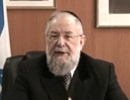Beit Midrash
- Sections
- Chemdat Yamim
- Parashat Hashavua
- Torah Portion and Tanach
- Bamidbar
- Pinchas
The Netziv (introduction to Bamidbar) deepened the idea along the thesis of the Chizkuni’s second answer. The reason that Chazal highlighted the censuses in Bamidbar is that there is great significance to the change in focus between the book’s beginning (in the desert) and end (preparing to enter the Land). In the desert, they were in a mode of grandeur with an abnormal life filled with miracles. In Eretz Yisrael, they followed natural paths, with Hashem leading them in a concealed manner. In the desert, it was like traveling in the day, and in Eretz Yisrael, it was like traveling at night. Divine Providence only showed flashes, like lightning at night. That is why in the first census, things were done according to the order of the banners, on four sides, like the "chariots" of the Divine Throne. That is the reason that Ephrayim is found there before Menashe. This was different in the 40th year counting in Pinchas. What the Netziv does not explain is what impact the nature of the census has on the choice of which son of Yosef to lead.
We will continue by melding together the Chizkuni’s two answers. Fundamentally, Ephrayim received the leadership of Yosef’s family from both Yaakov and Moshe. Yaakov put his right hand on Ephrayim’s head and said that people would bless their children by saying: "Hashem should make you like Ephrayim and Menashe" (Bereishit 48:20). Moshe also mentioned Ephrayim first in his closing beracha (Devarim 33:17). Not always did Menashe accept the second-place finish, as we see in Yiftach’s harsh reaction to the criticism of his brethren from Ephrayim (Shoftim 12).
On the eve of the entry into Eretz Yisrael, Bnei Yisrael came to the Gilad, which the tribe of Menashe viewed as home, especially the children of Menashe who came from an Aramite concubine, including Machir (see Divrei Hayamim I, 7:14). Our census puts great stress on this part of the family, as Machir and his descendants make up eight of the families mentioned (Machir, his son Gilad, and six of Gilad’s children). Since this part of the family seized an important leadership role, we understand why they were mentioned in a prominent location. In this context, we will look next week at the special status of the daughters of Tzlofchad in this matter.
Indeed we learn that every person has his unique contribution to make and role to fill. Leadership competition that hurts unity does not promote our interests.

Parashat Hashavua: 137 and the Power of Uncertainty
Rabbi Yossef Carmel | Cheshvan 5786

Present or Inheritance... or Both?
Various Rabbis | Tevet 5768

A Roving Capital
Rabbi Yossef Carmel | Tamuz 19 5775





















